'We wanted to position the whole region as a winter destination': Skiers can't go wrong heading to Quebec
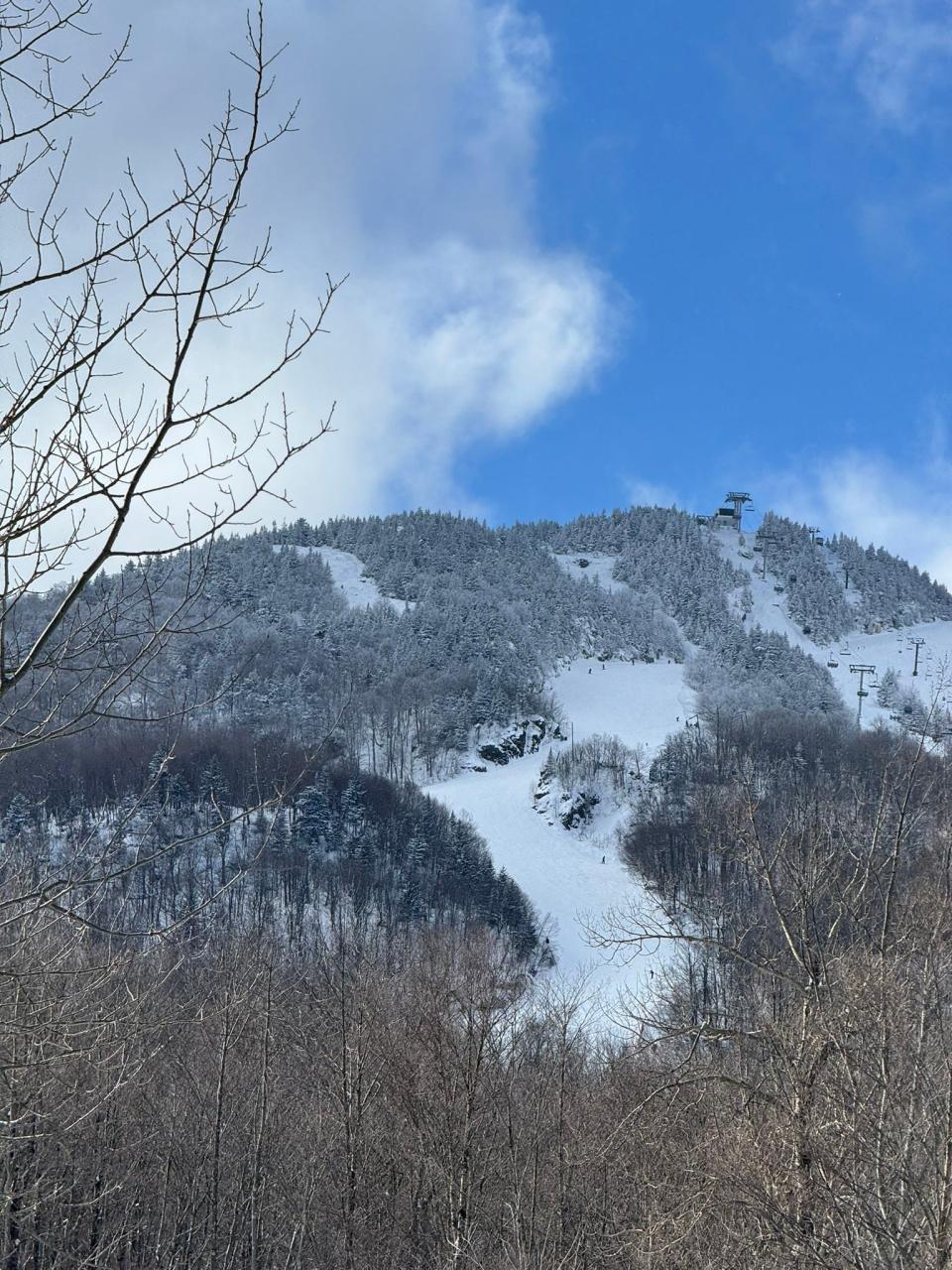
Quebec's Eastern Townships ski areas aren't just "Vermont North."
They’re only a few miles from the Vermont border, but they feel foreign, in a good way, and that's because they are, in overwhelmingly French-speaking Quebec. French Canadian culture is everywhere, from the cheese shops to fondue, mussels and local wines in the local taverns to the warm, informal friendliness of the locals, who take pride in their culture and their land.
A prime ski destination
The four resorts make up a key cache of ski area-rich Quebec, which boasts the most ski areas of any province or state in North America: a staggering 80. A distant second is New York with about 52. In recent years, skiing in Canada has been a tremendous value for Americans with a favorable exchange rate giving us a 30 percent discount on purchases.
Each of the Eastern Townships areas — Mont-Orford, Mont Sutton, Owl's Head and Bromont — offers an entirely different skiing and snowboarding experience than you'll find at New England resorts.
The topographies of these southern Quebecois mountains are just different. The peaks for the most part jut out of prairie land instead of dense mountainous forest like in Massachusetts, Vermont, New Hampshire and Maine and the percentage of challenging steep terrain is bigger than at most New England family resorts, though each also has good beginner and intermediate trails, with an emphasis on them at Bromont.
Magog
The region's hub town for ski visitors, Magog is 21 miles north of border, just northeast of Jay Peak. Perched on Lake Memphremagog, which stretches 31 miles into Newport, Vermont, Magog is a stately and classy home to about 25,000 year-round residents but swells to 70,000 in the summer, when Montrealers and Americans flock to the lake. The townships were at one time more English-speaking, but the number of resident Anglophones has dropped in recent decades. Many Quebecois people speak excellent English.
You're not going to find as big a selection as on Magog's Rue Principé (or Main Street) and lakeside drive of chic restaurants and shops or rustic taverns, pubs and brasseries in any Northeast ski town — including Stowe, North Conway and Lake Placid. And you're not going to find as arty and funky a ski town as Sutton hereabouts either. What you won't encounter is nearly as many of the raucous ski bars and clubs that dot the New England après ski landscape. For real nightlife, go to Mont Tremblant in the Laurentians, perhaps the Eastern Canada ski area best known to Americans and the biggest Quebec resort, though Le Masif de Charlevoix north of Quebec City boasts the most vertical feet, with 2,600 vertical.
The Eastern Township resorts are about a half-hour to 40-minute drive from each other, yet each has a distinct identity and vibe.
If I had to classify them having skied three of them over the President's Day weekend, I'd note that Orford, only six miles from Magog, at 1,933 vertical feet and 245 acres is the biggest, with the most gnarly and expansive terrain and modern lifts. By comparison, Waterville Valley in New Hampshire has 2,020 vertical feet on 265 skiable acres.
Mont-Orford
But Orford — situated in a beautiful national park and owned by a nonprofit organization — skis big. Cruising the 4-kilometer beginner trail from the summit of Mont-Orford, the highest of the ski area's three peaks, nastily steep gladed drops like Petit Canyon and Porc Epic fall away into what seems an abyss. The 2,789-foot peak is served by a hybrid lift consisting of high-speed, six-passenger chairs and eight-passenger gondola cabins.
The two other peaks are reached by conveyor-equipped, medium-speed, fixed-grip quads. Mont Alfred-Desrochers is a mostly beginner and intermediate area. Mont Giroux offers thrilling fall line skiing on its north and east-facing flanks. The eastern side sports a half-dozen super steep glades and draws sparse crowds.
Perhaps because of its amenities, breadth of terrain and proximity to Magog, Orford draws probably the biggest crowds in the Eastern Townships, though on a busy Saturday lift waits were shorter than at, say, Stratton, Mount Snow or Loon.
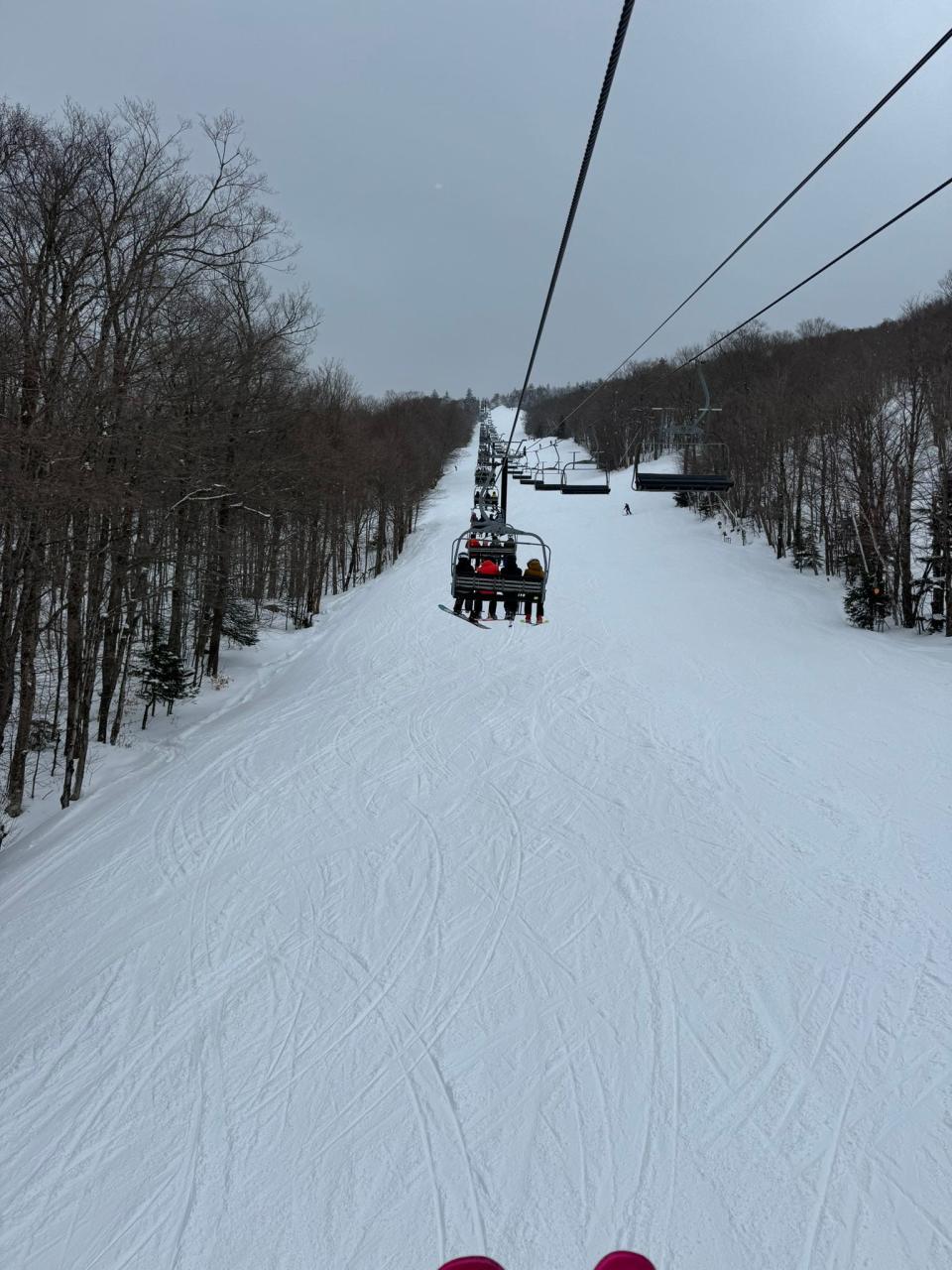
Sutton
About 40 minutes from Orford is Mont Sutton, much loved for its unique, natural approach to skiing. While it possesses considerable snowmaking and grooming capabilities, Sutton emphasizes glades and woods skiing and offers several beautiful forest routes for Alpine touring, for which it is something of a magnet for Eastern Townships skinners (Alpine touring participants stick climbing skins on their ski bases for the ascent). Sutton also boasts many challenging on-piste routes from the top.
My skiing friend, Kristin Helle of Westminster, and I had a wonderful morning at Sutton exploring the hill on our lightweight Alpine touring gear on two or three inches of new snow. For lunch at the rustic mountaintop chalet with its open wood-fired hearth, we met up with the resort's marketing director, Nadya Baron, a passionate advocate for Sutton's quirky and lovely ethos.
Baron noted that Sutton grooms some of its glades, with small, nimble snowcats built just for that purpose. She also noted that while Sutton has 60 trails, it includes 204 trail junctions, so tree skiers and riders can actually construct their own personal routes on every run. The mountain is permeated by glades and tree skiing, from extremely steep to gentle areas. Sutton's summit lies a bit below the round summits of the never-to-be-developed private land trust tract, the Green Mountain Nature Reserve owned by the Nature Conservancy Canada. Summer hiking is allowed there but no skiing.
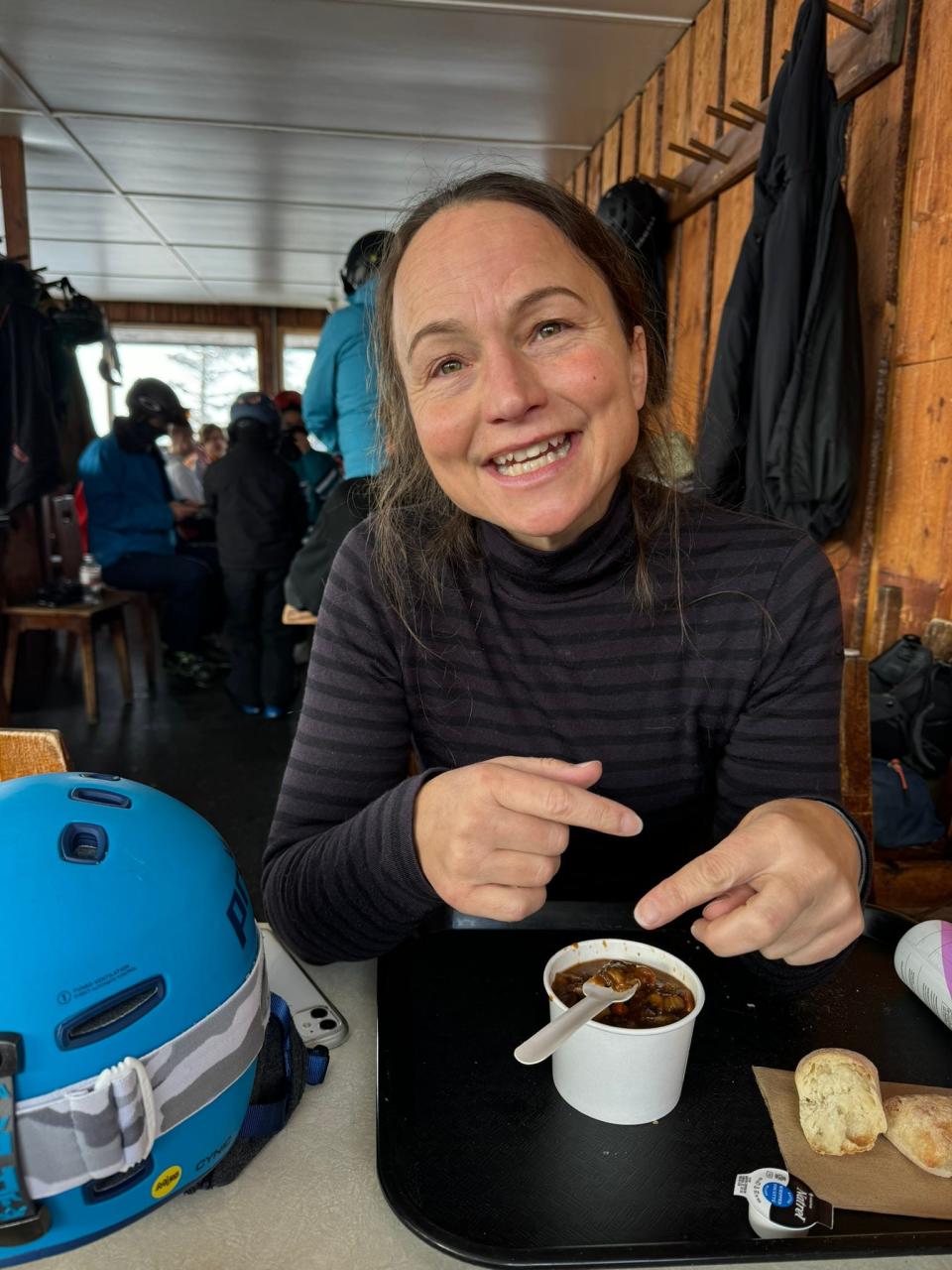
Tree skiing
"We have glades for all levels and this is very different. Usually, when we talk glades, we speak of expert terrain, but here we have glades for all levels," Baron said.
Sutton makes a distinction between trails, glades with their widely spaced trees and occasional grooming, and tree skiing zones. About 45 percent of Sutton's 230 skiable acres is composed of glades and tree skiing areas. The mountain offers 1,500 vertical feet of skiing, a few hundred vertical feet more than Bromley in Vermont, Cranmore in New Hampshire and Black Mountain of Maine, for example.
"We have normal trails, which we groom, glades that we sometimes groom, and tree skiing, which is even more natural and we never groom," she said.
But Baron emphasized the $7.2 million in investments independently owned Sutton has made in its infrastructure over the last six years, including $2.2 million last year for new snowcats, high-efficiency snowmaking guns and pipes and a new pumping station.
The Sutton lift fleet includes a high-speed quad (Quebec's first) two quads and six double chairs. For lodging, an intriguing option is Huttopia, the North American glamping operation that has a partnership with Sutton and offers high-end chalet and tent accommodations plus activities
After lunch, Baron led us into some of those whimsical glades and pointed out others all around us before dropping us at the portal to the backcountry uphill routes and asking us to text her when we were down to make sure we were safe.
The foray into the glades led Helle to explain why she wanted to return to Sutton.
"I'd definitely go back to overcome my fear of skiing in the trees by doing some of the more maintained glades," she said, adding that she was also struck by just how much steep terrain all three ski areas we skied offer, more than the local hills in southern Vermont.
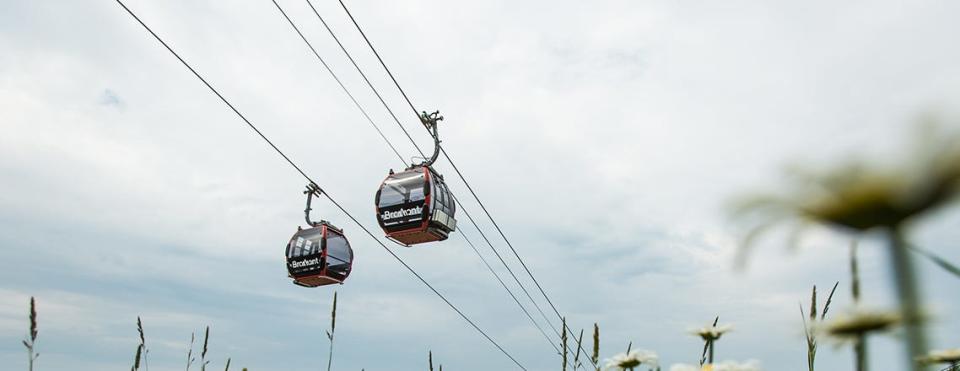
An uphill wonderland
As for the Alpine touring, it made me want more New England ski areas to apply the same care and thoughtfulness that Sutton and the other Eastern Townships areas put into making it a safe and serene experience.
The uphill routes at Sutton and at most Quebec ski areas are dedicated paths, ungroomed but marked, in the woods, with only occasional crossings with downhill trails, and these recede as you ascend. Sutton's uphill zones are gorgeous, tranquil and long, ranging from 2.4 to 1.5 miles. You are in the forest.
I don't get why more New England resorts don't do this. To be fair, Magic Mountain, Bolton Valley and Pico in Vermont offer dedicated uphill routes, though not with quite the variety as in Quebec.
It wouldn't kill ski areas here to clear narrow uphill paths off the busy ski trails. It would eliminate much of the risk and arguments about alpine tourers colliding with grooming machines and downhill skiers, and many of the rules.
At 11 miles from the border, Sutton is the closest Quebec ski area to the U.S. You owe this place a visit soon.
Meanwhile, though we did not visit Bromont on this trip, it is known for its extensive night skiing, high-end snowmaking and grooming capacity, family programs and terrain parks, plus a modern gondola. Bromont, with 1,300 vertical feet and an expansive 450 access, made news earlier this week by enrolling in the popular Mountain Collective multipass, joining Le Masif de Charlevoix as the only two Eastern Canada ski areas on the pass.
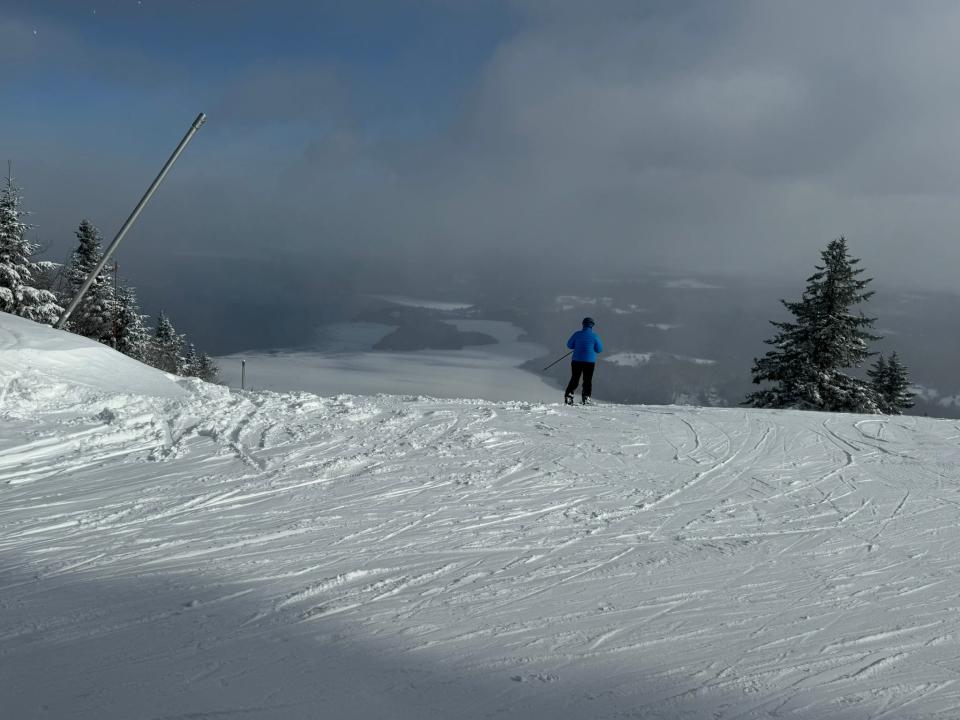
Owl's Head
Meanwhile, Owl's Head is a spectacular phenomenon. Knifing 1,772 vertical feet straight up above Lake Memphremagog (so-named in the Abenaki native language), on clear days it provides incredible views of the shimmering or white-topped lake and endless Quebec countryside, and a set of long, plunging steeps that you can see from miles away because of the mountain's unusual prominence. Wide intermediate cruisers snake around the periphery of this striking peak.
We were greeted by six to eight inches of fresh powder, temperatures in the teens, bluebird skies and zero liftlines on our visit to Owl's Head on President's Day. This is the least crowded and snowiest of the Eastern Townships ski areas, with the lake effect routinely spurring extra snowfall.
The high-speed summit quad permits endless lapping of Owl's Head's killer steeps such as the single black diamond Kamikaze under the lift, with its series of stacked up headwalls and the double black Colorado to skier's right off the top, plus a welter of double black glades near mid-mountain.
Of the Eastern Townships areas, Owl's Head's airy A-frame lodge is maybe the most comfortable, sunny and expansive, with splendid views of the whole hill. Regulars swear that the ski area is rarely crowded, even on weekends.
For foreign visitors, Tourism Eastern Townships offers a tremendous deal on lift passes for the Eastern Townships areas called the L'est Go card.
Great pass deal
Bought in advance, the card gives adults up to three days at any of the four resorts for $78 a day, $61 for under ages 13-25, $42 for kids 6-12 and $61 for seniors over 65. For four to eight days, the prices drop to $73, $57, $41 and $57.
Lysandre Michaud-Verreault, spokeswoman for Tourism Eastern Townships, noted that the region is known as Quebec's breadbasket, with many farms and wineries and gourmet dining options and wineries. Also, tourists should check out one of the 20 Nordic spas, in natural settings with their stations of invigorating saunas, steam rooms and cold plunges. We did, at the Spa Nordic Station in Magog, and it was an amazing experience. Lodging places in the area often have discount coupons for the spas and many local restaurants.
"The objective when we started the L'est Go pass a few years ago was to provide a product that so customers could discover the four ski resorts," Michaud-Verreault said. "So what is very particular in the Eastern Townships, if you compare them with Vermont or with other regions in Quebec, is that the four resorts are so close to each other, which means in the morning, you can go to Owl's Head and enjoy first tracks. Then you can go to Sutton, and then in the evening because it's a well-lit start station, you can go to Bromont.
"Before, people always had to make a choice to go to one or another and we did not want that." she added. "We wanted to position the whole region as a winter destination."
—Contact Shaun Sutner by e-mail at s_sutner@yahoo.com.
This article originally appeared on Telegram & Gazette: Skiers can't go wrong heading to the many resorts of value in Quebec

